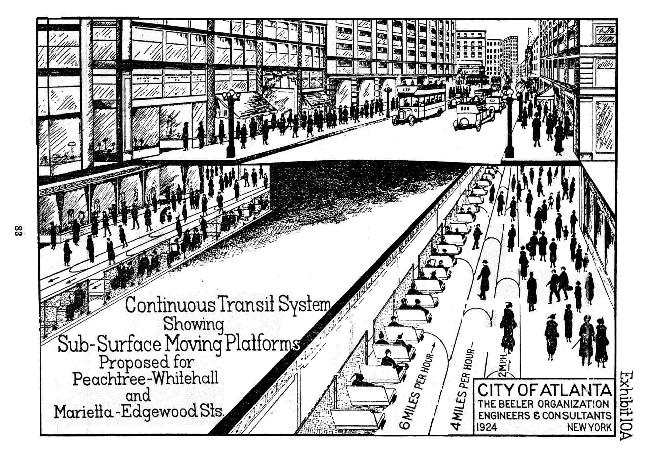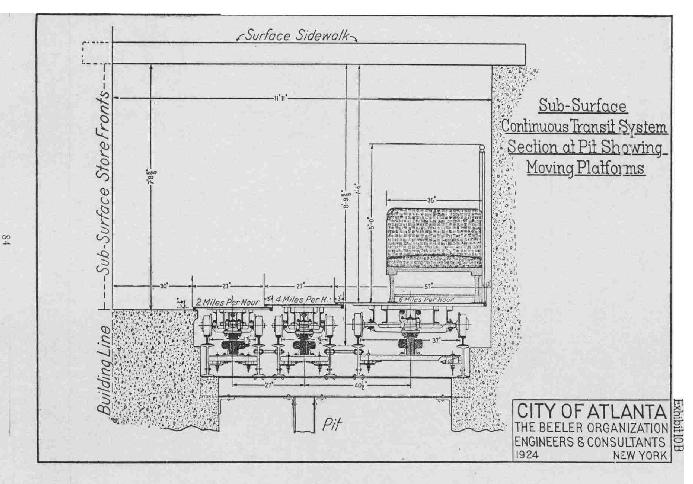Here's something I ran across quite some time ago on Jolomo.net (a great source of not so well known Atlanta history) that highlights one of the most unique aspects of Atlantan life: We are pretty close to insane when it comes to coming up with big projects and ideas. Boosters will usually refer to this unusual part of our DNA as Atlanta's "can-do spirit" or enshrine it in slogans such as the "City too busy to hate." Back here on Earth, my grandmother had a term for this she liked to call "crazy".
Don't get me wrong though as I am not saying this in a negative way. In fact, Atlanta's crazy bone is exactly what caused us to become the city we are today and an International player. However if you step back for a moment, and assess what has been done, these sort of ideas could have gone really really bad.
For example, why in the world should have Atlanta hosted the Olympics in 1996? Even though I feel that it was a success and wouldn't change us going after the hosting spot, on the list of cities that should actually have the Olympics we were probably tenth after Cleveland in 1992. Or how about Hartsfield-Jackson? When it was conceived that we should become the world hub of airline travel, there were probably no more than 100,000 people who even had a reason to come to Atlanta on a daily basis (and I'm being generous). Now, twice that number pass through Hartsfield-Jackson each day and we're a connected to world through it. And of course, who could forget MARTA. Many complain about it's lack of coverage, but considering when it was conceived and built, we were "shit house rat" crazy to even think a subway was a good idea.
So that finally brings me to the topic of my post today. MARTA is/was the culmination of a problem that has plagued Atlanta since day one: This city was never meant to hold humans. Not many anyway since it was meant to just be a rail hub and nothing more. Of course over time, Atlanta grew to a big city, and swelled in size in the post-bellum/pre-World War II era. By the early twentieth century Downtown was mangled mesh of freight and passenger rails lines, streetcars, cars, trucks, horses, and people.
Some improvements had been made such as the creation of the
viaducts to separate the freight lines from city streets (they had previously ran right down the middle of residential and commercial streets), but for the most part the sidewalks were crowded and, thanks to hardly any traffic laws, the streets were dangerous for pedestrians when they became too crowded to walk on. Also because of the lack of traffic laws, massive traffic pileups would occur when trolleys or automobiles clog the streets. It became at one point almost impossible to move around efficiently. A solution had to be found, and naturally that meant mass transit.
So, in the 1920s a study was commissioned by Georgia Power to study a way to build underground mass transit. It advanced pretty far, but then died before anything got off the ground. Before you get excited at the thought of plans for a Downtown Atlanta subway centered on 5 Points five decades before ground was broke on MARTA, think again. I told you before this is Atlanta and we are crazy. With that said, I present to you, the marvelous underground moving sidewalks and benches of Downtown Atlanta. Wait, what?



As you can see from the artist conceptions above, a secondary viaduct system would be built underneath Peachtree and Marietta streets that had three basic components:
1. A moving trolley of benches that person could walk up to and quickly get to different points around Downtown.
2. Two moving sidewalks (like those found on Airports) running at varying speeds of 4 and 2 miles per hour.
3. Basement level retail space with a normal, pedestrian only, sidewalk.
Above ground, pedestrians would have access to the system at various intersections not unlike a subway entrance, however no fare would ever be collected. Instead, funding of the system would come from taxing the surrounding business via some sort of sales tax.
There would be two lines:
North to south it would run under Peachtree starting at Mitchell Street and terminate at Carnegie Way at a length of about 3000 feet. West to East it would run under Marietta Street starting at Spring Street and what is now Peachtree Center Avenue at a length of about 2600 feet. The total distance covered by both routes would have been 5260 feet.
In addition to this system, the surface streets would be reconfigured to ease trolley and automobile congestion. This is where things took a turn for the crappy. The plan called for the following streets to become automobile only, proto-highway, streets (as in no sidewalks or pedestrian activity at all):
-Peachtree/Whitehall
-Spring
-Courtland
Other segments would become double decked to allow more automobile traffic, while other streets (unamed in the report) would solely have pedestrian and streetcar traffic.
There were also other flaws with this plan. The study showed that the Five Points intersection had 10,000 pedestrians per day. While that number sounds high, keep in mind that that Five Points Station today alone handles 50,000+ passengers per day on average. This does not account for the 10s of thousands of pedestrians that are in Downtown who drove there, or walked from other Downtown MARTA stations. Contrary to what many believe, pedestrian traffic during the day on Downtown sidewalks absolutely wallops that of the old days (but Downtown Atlanta at night today is absolutely crushed by the old days). In other words, had it been built, it would have not been able to be scaled up to meet the demands of the future since once the system was built, there was no way to expand it's capacity.
Another strike against the system (other than nothing like it has ever been done before and probably would have hard to pull off with the technology of hte day) is that there is a finite distance this type of transit can travel. It would only ever be useful in Downtown, and not for cross city travel. Basically, this sort of transit is built to order for what already exists. It could not be used to spur transit oriented development as the development is already there.
The cost to build this system, which isn't mentioned, probably wouldn't have been that cheaper than building a subway. The natural question then becomes, why not build a subway?
Fortunately, this crazy idea never saw the light of day. It is hard to say why, but chances are that the Great Depression killed this silly idea or was just flat out laughed out of the halls of city council. Below you can find a link to the report here (unfortunatley it is not the full report, and there is also evidence this may have been only one version of a proposed system):
http://jolomo.net/atlanta/continuous.html



